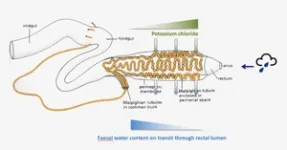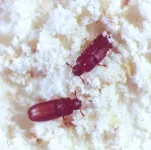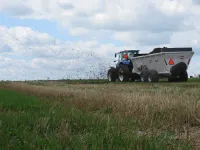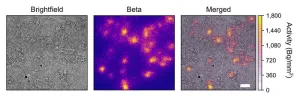(Press-News.org) "Have you ever wondered about life on a leaf?"
Great Lakes Bioenergy Research Center (GLBRC) researcher Ashley Shade asks a simple question, but it’s one well worth investigation. The aboveground part of plants where microbes reside, or the phyllosphere, represents the largest environmental surface area on the plant. Much of this area is grown as cultivated agriculture, and understanding the interactions between plants and the microorganisms that live on their surfaces may help us develop agricultural management practices that can increase crop productivity and resilience. In their newly published study, Department of Energy Bioenergy Research Center collaborators at GLBRC and the Center for Advanced Bioenergy and Bioproducts Innovation (CABBI) peer into the complexities of life on a leaf.
Perennial plants like switchgrass and miscanthus are a crucial target for the sustainable development of biofuels. In addition to yielding large amounts of biomass that can be converted into biofuels and bioproducts, perennial crops offer a broad range of ecosystem services that support efforts to mitigate climate change, such as sequestering greenhouse gases and driving nutrient cycling in the soil.
Like all plants, perennials are home to a wide variety of microbes, and many of these microbes benefit their hosts. For example, some plant-associated microbes can increase the plant’s productivity and offer some protection against environmental stressors like heat and drought. Because of this, management of the plant microbiome is one tool proposed to promote crop growth and resilience, which is particularly important in the face of global climate change. Along with selective breeding and data-informed field practices, microbiome management is expected to be instrumental in the sustainable production of biofuel feedstocks.
Different parts of a plant are home to different microbes. Many researchers in recent years have studied the plant-microbe interactions that take place in the rhizosphere — the belowground area around the roots — which play a key role in a plant’s ability to uptake water and nutrients. However, the aboveground phyllosphere, which includes the surfaces of leaves, is also home to some very important microorganisms. Namely, phyllosphere microbes are known to play roles in carbon cycling and protecting plants from harmful pathogens. Because perennial biofuel feedstocks like miscanthus and switchgrass are often selected to maximize leaf surface area, understanding the phyllosphere microbiome and the plant-microbe interactions that take place there is expected to play a very significant role in our ability to improve feedstock production.
In the newly published study, “Seasonal Activities of the Phyllosphere Microbiome of Perennial Crops,” researchers used cutting-edge gene sequencing and bioinformatic tools to identify what microbes live and grow on the leaves of bioenergy crops, and how these microbes respond to plants throughout the growing season.
The study, published in Nature Communications, was led by CABBI Sustainability Theme researcher Adina Howe, an Iowa State University Associate Professor of Agricultural and Biosystems Engineering; and GLBRC's Shade, a Michigan State University Associate Professor of Plant, Soil, and Microbial Sciences.
“Miscanthus and switchgrass are known to share common phyllosphere microbes,” Howe said. “In this study, we show when they’re actively growing and identify what they are doing. Living on the leaf, these microbes can biosynthesize natural products that may be important for responding to plant stressors.”
To study the leaf microbiomes and their dynamics throughout the growing season, the researchers collected switchgrass and miscanthus leaf microbiomes monthly from May to November.
From these samples, the research team sequenced the microbiomes’ metagenomes and metatranscriptomes. A metagenome is a collection of all the genes that can be found among individuals in a group (i.e., the pool of genes that could potentially be expressed), while a metatranscriptome specifically refers to the genes that are actively being expressed by individuals in a group. Using bioinformatic tools, the microbiomes’ metagenomes and metatranscriptomes were analyzed, revealing the types of microbes present in the phyllosphere and their gene expression throughout the growing season.
This study indicates that leaf microbes are actively growing and expressing genes that produce various metabolites. For example, genes associated with terpene production were frequently expressed in the phyllosphere. Terpenes are interesting because they are used as signaling molecules in plants and bacteria and can help protect plants from stress. Terpenes are also involved in the regulation of production of nitric oxides and methane, which are powerful greenhouse gases. This study also found that different groups of microbes varied in abundance and metabolic function over the growing season, suggesting that they may be responding to different plant cues.
Overall, this research points to specific microbial functions that could be targeted for future plant-microbe management, which could be used to promote crop growth and resilience.
Though small, life on a leaf might just be one of the keys to a more sustainable future.
Co-authors on this study include GLBRC team members and collaborators Nejc Stopnisek, Shane Dooley, Fan Yang, and Keara Grady.
END
CABBI/GLBRC team explores leaf microbiome in perennial bioenergy crops
Multi-BRC study shows that life on a leaf might be a key to a sustainable future.
2023-03-21
ELSE PRESS RELEASES FROM THIS DATE:
Turn off porch light to aid caterpillars — and safeguard backyard ecosystems
2023-03-21
ITHACA, N.Y. – Moderate levels of artificial light at night – like the fixture illuminating your backyard – bring more caterpillar predators and reduce the chance that these lepidoptera larvae grow up to become moths and serve as food for larger prey.
This ecological impact was demonstrated in a new Cornell University study published in the Proceedings of the Royal Society B: Biological Sciences.
The scientists placed more than 550 lifelike caterpillar replicas made of soft clay in a forest, setting to ascertain how the mockups were attacked and hunted by predators compared to a control group.
“We measured predation ...
Anne Kornahrens, Hertz Foundation Director of Community, selected as delegate to International Younger Chemists Network Assembly
2023-03-21
The Fannie and John Hertz Foundation is proud to announce that Anne Kornahrens, Director of Community, has been selected as a 2023 U.S. delegate to the International Younger Chemists Network (IYCN) Assembly.
Kornahrens will attend the 52nd International Union of Pure and Applied Chemistry (IUPAC) General Assembly and World Chemistry Congress, to be held in The Hague, Netherlands, August 18–25, 2023.
The IUPAC Young Observer Program strives to introduce the work of IUPAC to a new generation of distinguished researchers and to provide them with an opportunity to address international science policy issues. IYCN, an affiliated ...
Novel drug makes mice skinny even on sugary, fatty diet
2023-03-21
SAN ANTONIO (March 21, 2023) — Researchers from The University of Texas Health Science Center at San Antonio (UT Health San Antonio) have developed a small-molecule drug that prevents weight gain and adverse liver changes in mice fed a high-sugar, high-fat Western diet throughout life.
“When we give this drug to the mice for a short time, they start losing weight. They all become slim,” said Madesh Muniswamy, PhD, professor of medicine in the health science center’s Joe R. and Teresa Lozano Long School of Medicine.
Findings by the collaborators, also from the University of Pennsylvania and Cornell University, were published Feb. 27 in the high-impact journal Cell ...
Department of Energy announces $150 million for research on the science foundations for Energy Earthshots
2023-03-21
WASHINGTON, D.C. - Today, the U.S. Department of Energy (DOE) announced $150 million for research into the crosscutting foundational science for multiple Energy Earthshots. This funding, provided by the Office of Science, will support fundamental research to accelerate breakthroughs in support of the Energy Earthshots Initiative.
“Our Energy Earthshot solutions start with science,” said Asmeret Asefaw Berhe, DOE’s Director of the Office of Science. “The Office of Science is working to find those solutions by supporting research that will target the remaining and emerging scientific challenges underlaying ...
Turn up your favorite song to improve medication efficacy
2023-03-21
EAST LANSING, Mich. – While listening to a favorite song is a known mood booster, researchers at Michigan State University have discovered that music-listening interventions also can make medicines more effective.
“Music-listening interventions are like over-the-counter medications,” said Jason Kiernan, an assistant professor in the College of Nursing. “You don’t need a doctor to prescribe them.”
While previous research studies have used music-listening interventions as a tool to treat pain and anxiety, Kiernan took a novel approach by studying the effects of music-listening interventions ...
Local manure regulations can help reduce water pollution from dairy farms
2023-03-21
URBANA, Ill. – Animal agriculture is a major source of water pollution in the United States, as manure runoff carries excess nutrients into rivers and lakes. Because of their non-point source nature, most farms are not regulated under the federal Clean Water Act. This leaves pollution control up to the states, resulting in a patchwork of different approaches that are difficult to evaluate.
A new study from the University of Illinois focuses on local manure management regulations in Wisconsin and how they affect water ...
Analysis by NYUAD researchers offers new insights into causes of persistent inequities affecting non-white scientists and their research
2023-03-21
Abu Dhabi, UAE, March 21, 2023 – A team of NYU Abu Dhabi (NYUAD) researchers, including data and computational social scientists, is reporting new findings that highlight previously unknown ways through which non-White scientists suffer from inequalities when it comes to the process of having their research considered, published, and cited, potentially hindering the advancement of their academic careers. Specifically, the NYUAD team’s analysis found fewer non-White editors than would be expected based on their share of authorship. In addition, non-White scientists endure longer waiting times between the submission ...
New compact and low-cost lensless radiomicroscope developed for nuclear medicine imaging
2023-03-21
Reston, VA—A novel imaging modality that can visualize the distribution of medical radiopharmaceuticals with very fine resolution has been developed and successfully tested, according to research published in the March issue of The Journal of Nuclear Medicine. Known as the lensless radiomicroscope, the palm-sized instrument offers the same level of imaging performance as its closest imaging equivalent but comes with significantly larger field of view and costs less than $100.
“While many nuclear medicine imaging modalities can quantitively measure ...
Patients with baclofen pumps may safely undergo transcutaneous spinal stimulation
2023-03-21
East Hanover, NJ. March 21, 2023. Researchers from Kessler Foundation and Kessler Institute for Rehabilitation (collectively “Kessler”) conducted the first prospective study to assess whether transcutaneous spinal stimulation (TSS) interacts with implanted intrathecal baclofen (ITB) pump delivery systems for managing spasticity. The article, "Transcutaneous spinal stimulation in patients with intrathecal baclofen pump delivery system: A preliminary safety study," (doi: 10.3389/fnins.2022.1075293), was published December 21, 2022, in Frontiers in Neuroscience. It is ...
Co-infection with ‘superbug’ bacteria increases SARS-CoV-2 replication up to 15 times, Western study finds
2023-03-21
Global data shows nearly 10 per cent of severe COVID-19 cases involve a secondary bacterial co-infection – with Staphylococcus aureus, also known as Staph A., being the most common organism responsible for co-existing infections with SARS-CoV-2. Researchers at Western have found if you add a ‘superbug’ – methicillin-resistant Staphylococcus aureus (MRSA) – into the mix, the COVID-19 outcome could be even more deadly.
The mystery of how and why these two pathogens, when combined, ...
LAST 30 PRESS RELEASES:
Understanding the role of linear ubiquitination in T-tubule biogenesis
Researchers identify urban atmosphere as primary reservoir of microplastics
World’s oldest arrow poison – 60,000-year-old traces reveal early advanced hunting techniques
Bristol scientists discover early sponges were soft
New study uncovers how rice viruses manipulate plant defenses to protect insect vectors
NSF–DOE Vera C. Rubin Observatory spots record-breaking asteroid in pre-survey observations
Ribosomal engineering creates “super-probiotic” bacteria
This self-powered eye tracker harnesses energy from blinking and is as comfortable as everyday glasses
Adverse prenatal exposures linked to higher rates of mental health issues, brain changes in adolescents
Restoring mitochondria shows promise for treating chronic nerve pain
Nature study identifies a molecular switch that controls transitions between single-celled and multicellular forms
USU chemists' CRISPR discovery could lead to single diagnostic test for COVID, flu, RSV
Early hominins from Morocco reveal an African lineage near the root of Homo sapiens
Small chimps, big risks: What chimps show us about our own behavior
We finally know how the most common types of planets are created
Thirty-year risk of cardiovascular disease among healthy women according to clinical thresholds of lipoprotein(a)
Yoga for opioid withdrawal and autonomic regulation
Gene therapy ‘switch’ may offer non-addictive pain relief
Study shows your genes determine how fast your DNA mutates with age
Common brain parasite can infect your immune cells. Here's why that's probably OK
International experts connect infections and aging through cellular senescence
An AI–DFT integrated framework accelerates materials discovery and design
Twist to reshape, shift to transform: Bilayer structure enables multifunctional imaging
CUNY Graduate Center and its academic partners awarded more than $1M by Google.org to advance statewide AI education through the Empire AI consortium
Mount Sinai Health system receives $8.5 million NIH grant renewal to advance research on long-term outcomes in children with congenital heart disease
Researchers develop treatment for advanced prostate cancer that could eliminate severe side effects
Keck Medicine of USC names Christian Pass chief financial officer
Inflatable fabric robotic arm picks apples
MD Anderson and SOPHiA GENETICS announce strategic collaboration to accelerate AI-driven precision oncology
Oil residues can travel over 5,000 miles on ocean debris, study finds
[Press-News.org] CABBI/GLBRC team explores leaf microbiome in perennial bioenergy cropsMulti-BRC study shows that life on a leaf might be a key to a sustainable future.






